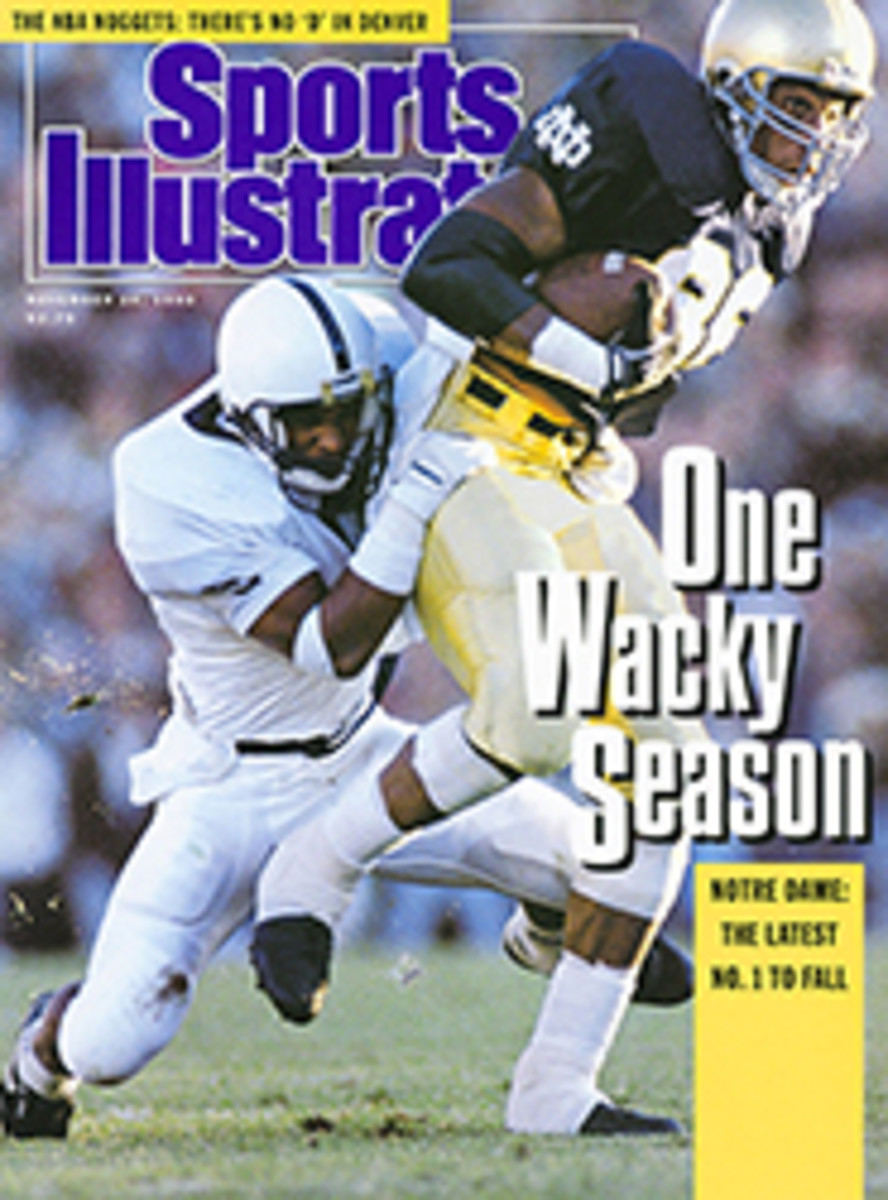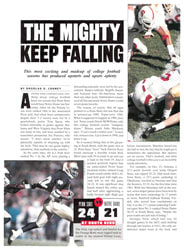
OLDER AND WISER, NOW HE'S FAST EDDIE FOR SURE
Eddie Cheever's right foot leans harder on the gas pedal of the pace car, sending the engine's note up several octaves and the big Day-Glo digits on the dashboard toward 90 mph. Pit row blurs by as he guides the magenta Oldsmobile convertible along the deserted straightaway at Portland International Raceway. "See those?" he says to his passenger, pointing at the two long yellow concrete blocks framing the first of nine turns of the track. "You aim the car between them." As the car reaches the markers, Cheever's foot eases off the throttle and taps the brake, and the digit on the dash becomes 70. Cheever maintains his speed and negotiates the next curve with only his left hand on the steering wheel. "This is just one big puppy-dog leg," he says, his free hand gliding through the air, mimicking the car's movement. "You're hardly moving the steering wheel at all." To drive the point home, he yanks the wheel as he enters the next turn and the car careens to the edge of the track. He must dance on the brake pedal to make the car regain equilibrium. Over the piercing screech of overworked tires, Cheever shouts, "If you have to do this, you won't be in position to take the next turn at top speed!"
Unnerving as it may be for the uninitiated, this is a relaxing drive in the country for Cheever, who 16 times this year wedged himself into an Indy Car, lowered the visor on his Stars and Stripes-adorned helmet and did the same maneuvers at speeds—depending on the racetrack—up to three times as fast. The 32-year-old former Formula One driver did it so well on the Championship Automobile Racing Teams (CART) series that he finished ninth in the overall standings and earned $724,720 plus a $50,000 bonus as Rookie of the Year. Many observers are convinced that Cheever will follow the tire-track steps of Emerson Fittipaldi, another former F/1 driver, who went on to win the Indy 500 and the CART points championship in 1989.
Cheever has traveled a long road, with some very unexpected twists, to reach this point. In 1962, when he was four years old, Cheever's parents, who are now divorced, left Phoenix to open a chain of health clubs in Europe. He grew up in Rome, speaking English and playing basketball with other Americans at Notre Dame School, but speaking Italian and racing go-karts with his neighborhood friends.
By the time he was 17, Cheever was racing open-wheel cars and was definitely on the fast track to becoming a Grand Prix driver. Danny Sullivan, winner of the 1985 Indy 500, was racing Formula Three cars in Europe when Cheever stormed onto the scene. Sullivan recalls that "everyone said Eddie was going to be the guy." In 1978, barely out of his teens, Cheever got his first Formula One ride, and it seemed only a matter of time before he would win the world driving championship.
That time could not come too soon for Cheever, who had grown up with a sort of expatriate version of a Little League father. Edward McKay Cheever Sr. was an intense businessman who was equally passionate about racing. In pursuit of racing success, Cheever Sr. had put his son on a vegetarian diet, and made him run three miles a day and study karate after school. "He pushed the buttons, and I went through the motions," the younger Cheever says. "Racing was something I wanted to do probably more for the favor of my father, since I didn't see him very much. If he wanted me to go fast, I'd go as fast as I could."
Cheever's first full season in F/1 was 1980. He was only 22, but he was sleeping three or four hours a night and had an ulcer. Ten years later he still had not won the championship; in fact, he had not won a single Grand Prix race in 133 attempts. Surprisingly, Cheever's reputation as a driver did not suffer. Most observers ranked him among the top-echelon drivers and excused his lackluster record by noting that he had shown little talent for playing politics in order to land a car equal to his talent.
At the end of 1989 Cheever planned to switch from F/1 to sport/prototype racing, driving for Jaguar, in whose cars he had won seven of the 16 events he had found the time to enter in 1987 and '88. He had earned enough money on the Grand Prix circuit to assure himself of a comfortable living for years to come, and his relationship with his family had matured. He is on good terms now with both his father and mother, but he is quick to say, "The family has nothing to do with my decisions. I figure that when they don't pay the bills, they should have nothing to say about what I do."
A decade ago sport/prototype endurance racing might have been the only option open to Cheever, but the growing purses and prestige of Indy Car racing have lured increasing numbers of Formula One drivers to the ranks of CART—not only Indy 500 winners-to-be Sullivan and Fittipaldi, but also Teo Fabi, Roberto Guerrero, Raul Boesel and Derek Daly. "Growing up in Europe, the only thing I saw was Formula One, but racing at Indianapolis is something I've always wanted to do," Cheever says. "My father used to tell me how he went and saw Indy the year I was born, and Jim Bryan, a guy from Tucson, won."
Even with the Jaguar deal pending, Cheever arranged a meeting with Indy Car-owner Chip Ganassi last December. It went well, and the day after Christmas, Ganassi called Cheever in Monte Carlo to offer him a ride with his team. On New Year's Day, the two men faxed each other signed contracts.
"Hyper" is the way Ganassi Racing's team manager, Tom Anderson, describes Cheever. "In a lot of ways, he's like a little boy right now," Anderson says. "You have to lead him around until he knows which direction he's going." Cheever learned quickly enough to score nine top-10 finishes on race courses that he was seeing for the first time.
Cheever has also taken up golf for the first time. Speed is such an ingrained way of life for him that when his Italian-born wife, Rita, complained that golf was taking up too much of his time, Cheever's solution was not to cut back on how many rounds he played, but to cut back on the time it takes to play them.
Cheever regularly shoots in the 80s, and despite all the rushing around, his interest in golf is a signal that he is learning to relax off the track. "Five years ago I would have laughed if someone had told me to play golf, but I enjoy it more than almost anything," says Cheever, whose English is tinged with the trace of a Continental accent. He also is fluent in French, and he uses top-gear Italian around Rita, the teenage sweetheart he married a decade ago, and their 1½-year-old daughter, Estelle.
Cheever has developed the ability to peel off every vestige of the racer's life along with his fireproof overalls. At his Aspen, Colo., home, there's virtually no talk of cars. "My family life is an oasis I can come home to," he says.
Cheever doesn't much care for cars, and he is not that fond of driving when he's not on a race circuit. While you're mulling that bit of irony, take this down: Cheever gets carsick. It used to happen frequently during races, but now Cheever is resigned to not eating before a race.
Sullivan believes Cheever has less to adapt to than other road-course specialists were obliged to because there are fewer oval track races on the CART schedule—only five of 16 races this past season. But as long as the 2.5-mile Indianapolis Motor Speedway is around and the biggest prize in motor sports is awarded there, Ovals 101 will be the most important course for CART. Cheever, who calls the ovals either "the most exhilarating experience a driver can have" or "far and away the most frightening," has been taking copious notes. Fittipaldi knows firsthand how difficult the road-to-oval transition can be. In a phone conversation at the beginning of the Indy Car season, the two-time F/1 champion cautioned Cheever to take it slow. "On road circuits the speeds are lower, and you can make mistakes and recover, but oval tracks are not forgiving," Fittipaldi said. "At first you go quick—but not so quick—and you gain more experience. Then you go faster."
Still, for much of the two weeks of practice leading up to the Indy 500, it did not seem as if Cheever were ever going to go faster. The infamous Turn One at the end of the Speedway's 3,320-foot-long front straight had him badly spooked, and he kept braking going into it. Cheever consulted with Ganassi (who had been the fastest rookie qualifier at the Speedway in 1982), Sullivan and Rick Mears, but despite their encouragement and tips, he was still tapping the brake pedal. "They kept telling me to go into it full throttle," he says. "But for me it was natural to try to slow the car down. Every time around I kept focusing my eye on what patch of wall I thought was going to be mine."
Then, walking out of the pits one day, Cheever spotted three-time Indy champion Bobby Unser, who now does commentary for ABC Sports. Cheever told him about his problems with Turn One.
"Where are you looking?" Unser asked.
"At the wall," Cheever said.
"That's a mistake," said Unser. "Forget that. Look at the groove." With Unser's advice echoing in his head, next time out, Cheever concentrated on the trail of tire rubber laid down by the fastest cars. He picked up 3 mph. He qualified for the 500 with a rookie-record average of 217.926 mph.
On race day Cheever sat on the grid in the middle of the fifth row, in the 14th position, going through his version of the routine known as "taking the air out of the balloon," a ritual that most drivers follow in one form or another to calm themselves before the start of a race. Things were settling down nicely until Cheever heard The Star-Spangled Banner. "I started thinking about all those people out there, where I was and what the start would be like, and pretty soon the balloon got so big it almost exploded," Cheever says, burying his face in his palms and shaking his head as he recalls the moment. Once the race got under way, he quickly calmed down and went on to finish eighth.
Cheever gets hyper all over again when he thinks about the coming Indy Car season. For one thing, the team will begin the season with a new car, not one left over from the previous year. And not only Cheever, but also much of the team had been learning the ropes in 1990. Team manager Anderson and chief-mechanic Chris Griffis were also rookies in their roles. "Now I find myself digging to the bottom of my soul, trying to get the most out of what I have available, because I know I have a chance to win," Cheever says. He squints to marvel at a hovering hummingbird and the snow-capped peaks of the mountains outside his Aspen home. "What I need now is a winning car, and my life will be exactly as I'd always planned."
TWO PHOTOS
GEORGE OLSON
Tips from Fittipaldi (below, left) helped Cheever score nine top-10 finishes and become CART rookie of the year.
PHOTO
PASCAL RONDEAU/ALLSPORT UK LTD
Ten years of Grand Prix racing had put a damper on Cheever's once-promising career.

